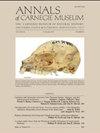IF 0.9
4区 地球科学
Q4 PALEONTOLOGY
引用次数: 10
摘要
摘要:本文报道了在玻利维亚安第斯山脉亚马逊流域的Yungas森林中发现的一种新的单种Oreobates jimnez de la Espada, 1872年,推断其系统发育位置,重新审视了Oreobates的系统发育关系,并讨论了证明单一标本描述该物种的条件。新物种,Oreobates yanucu,不同于所有其他Oreobates外部条件的组合:颗粒与分散疣背侧皮肤,我的时间比手指II, III和IV手指的指尖明显扩大和截断轮廓,脚趾尖二世与爪的襟翼V,长于宽,基底织物之间的第二和第三脚趾I和II和脚趾,脚长度/ snout-vent = 50%,缺乏橙色,红色,或红色斑点,斑点。尽管在外观上与O. amarakaeri Padial等人(2012)、O. choristolemma (Harvey and Sheehy, 2005)、O. granulosus (Boulenger, 1902)、O. sanctaecrucis (Harvey and Keck, 1995)和O. sanderi (Padial等人,2005)相似——所有这些物种都来自玻利维亚和秘鲁南部的Yungas,属于单系类群——但新物种是在一个进化枝中嵌套的,这是由分子系统发育揭示的。其中所有物种都有扩大的指盘,是O. berdemenos Pereyra等人(2014)的姐妹,后者是来自阿根廷Yungas的异乡物种。新物种仅从1999年在卡拉斯科国家公园(玻利维亚科恰班巴省查帕雷省)海拔1500米采集的单一标本中得知。Oreobates现在包括24个已被描述的物种,但还有7个新物种尚未正式命名,我们预计随着对玻利维亚和秘鲁安第斯山麓的探索,这一群体的多样性将大大增加。本文章由计算机程序翻译,如有差异,请以英文原文为准。
Description and Phylogenetic Position of a New (Singleton) Species of Oreobates JiméNez De La Espada, 1872 (Anura: Craugastoridae) from the Yungas of Cochabamba, Bolivia
ABSTRACT We report the discovery of a new singleton species of Oreobates Jiménez de la Espada, 1872, from the Yungas forest of the Amazonian versant of the Andes in Bolivia, infer its phylogenetic position, revisit the phylogenetic relationships of Oreobates, and discuss the conditions that justify description of the species with a single specimen. The new species, Oreobates yanucu, differs from all other Oreobates in a combination of external conditions: granular dorsal skin with scattered warts, finger I longer than finger II, finger tips of fingers III and IV distinctly enlarged and truncate in outline, tips of toes II to V with ungual flaps, head longer than wide, basal webbing between toes I and II and toes II and III, foot length/snout—vent length = 50%, lack of orange, red, or scarlet flecks and blotches in life. Although similar in appearance to O. amarakaeri Padial et al., 2012, O. choristolemma (Harvey and Sheehy, 2005), O. granulosus (Boulenger, 1902), O. sanctaecrucis (Harvey and Keck, 1995), and O. sanderi (Padial et al., 2005)—all of them species from the Yungas of Bolivia and southern Peru conforming a monophyletic group—the new species is nested within a clade, revealed by molecular phylogeny, in which all species share the condition of enlarged finger discs and is sister to O. berdemenos Pereyra et al., 2014, an allopatric species from the Yungas of Argentina. The new species is only known from a single specimen collected in 1999 at 1500 m above sea level within Carrasco National Park (Provincia Chapare, Departamento Cochabamba, Bolivia). Oreobates now includes 24 described species but seven other new species remain to be named formally and we expect the diversity of this group to increase considerably with the exploration of the Andean foothills of Bolivia and Peru.
求助全文
通过发布文献求助,成功后即可免费获取论文全文。
去求助
来源期刊

Annals of Carnegie Museum
综合性期刊-动物学
CiteScore
2.50
自引率
18.20%
发文量
4
审稿时长
>12 weeks
期刊介绍:
Annals of Carnegie Museum is a quarterly journal that publishes peer-reviewed short and medium-length original scientific contributions in organismal biology, earth sciences, and anthropology, in 40 by 52.5 pica format (168 by 220 mm or 6-5/8 by 8-5/8 inches). Subject matter must be relevant to Carnegie Museum of Natural History scientific sections or Powdermill Nature Reserve (PNR), preferably with connection to the Carnegie collection and/or personnel. Carnegie Museum staff and research associates receive publication priority, but others are encouraged to submit papers, especially those manuscripts explicitly based on the Carnegie collection.
 求助内容:
求助内容: 应助结果提醒方式:
应助结果提醒方式:


